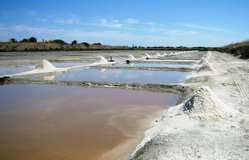
Salt pan (geology)
Natural salt pans or salt flats are flat expanses of ground covered with salt and other minerals, usually shining white under the Sun. They are found in deserts, and are natural formations (unlike salt evaporation ponds, which are artificial).
Overview
A salt pan forms by evaporation of a water pool such as a lake or pond. This happens in climates where the rate of water evaporation exceeds the rate of precipitation, that is, in a desert. If the water cannot drain into the ground, it remains on the surface until it evaporates, leaving behind minerals precipitated from the salt ions dissolved in the water. Over thousands of years, the minerals (usually salts) accumulate on the surface. These minerals reflect the Sun's rays and often appear as white areas.
Salt pans can be dangerous. The crust of salt can conceal a quagmire of mud that can engulf a truck. The Qattara Depression in the eastern Sahara desert contains many such traps which served as strategic barriers during World War II.
Salt pan
Salt pans can refer to:
See also

Salt evaporation pond
Salt evaporation ponds, also called salterns or salt pans, are shallow artificial ponds designed to extract salts from sea water or other brines. The seawater or brine is fed into large ponds and water is drawn out through natural evaporation which allows the salt to be subsequently harvested. The ponds also provide a productive resting and feeding ground for many species of waterbirds, which may include endangered species. The ponds are commonly separated by levees.
Natural salt pans are geological formations that are also created by water evaporating and leaving behind salts.
Algae and colour of evaporation ponds
Due to variable algal concentrations, vivid colors – from pale green to bright red – are created in the evaporation ponds. The color indicates the salinity of the ponds. Microorganisms change their hues as the salinity of the pond increases. In low- to mid-salinity ponds, green algae such as Dunaliella salina are predominant, although these algae can also take on an orange hue. In middle- to high-salinity ponds, Halobacteria, which is actually a group of halophilic Archaea (sometimes called Haloarchaea), shift the colour to pink, red and orange. Other bacteria such as Stichococcus also contribute tints.
Podcasts:

